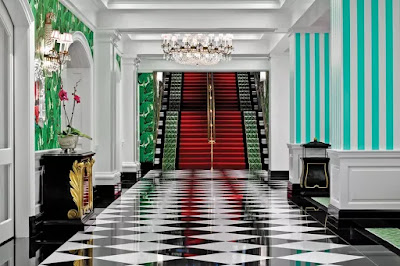WEEK 10 - Modernism in America (Part One)
Modernism started in Germany and France, and it spread from those countries to many other countries throughout the globe. Travel, journals, books and exhibitions were some of the vehicles that carried the lessons of modernism worldwide. The effects of World War II also contributed to the spread. The war forced Bauhaus to close, and compelled many of the designers to emigrate to Britain, the United States, Brazil, Argentina, Kenya, and Japan. Many of the pioneers of modernism, such as Walter Gropius, Le Corbusier, and Mies van der Rohe, fled from their original countries and ended up in the United States.
The Unites States was not as affected by the war as many European countries. After the war, many European countries were in a desperate state, and for the years that followed they were still trying to recover from the hit. America, on the other hand, was in good economic shape, and in the years between 1950-1970, it was the world leader economically.
The 1950's in America was a great time for design. The government encouraged the growth of homeowners by offering subsidies for first-time homeowners. The increase in the amount of homeowners led on an increase in the demand of home furnishings and designers.
The manufacturing process played a huge role during this period. During the war, it was used by the military for the production of war equipment. However, now it could be applied to furniture-making, and great results were created using molded plywood and molded plastic.
Historical Examples:
 |
| Glass House by Philip Johnson 1949 New Canaan, United States |
 |
| Kaufmann House by Richard Neutra 1946 Palm Springs, California, USA |
 |
| Falling Water by Frank Lloyd Wright 1935 Pennsylvania, USA |
Current Applications:
One Step Further...
Richard Joseph Neutra is an Austrian-born American architect, born in 1892, in Vienna. He studies at Vienna University of Technology, with Adolf Loos and Otto Wagner, and at the University of Zurich. He moved to the United States in 1923, and worked for the firm of Holabird and Roche in Chicago and with Frank Lloyd Wright at Taliesin in Spring Green, Wisconsin.
Neutra moved to Los Angeles in 1926 and established his own practice. It is there that he designed his most important early work, the Lovell House. This house is stylistically similar to the works of Le Corbusier and Mies van der Rohe in Europe, with glass expanses and cable-suspended balconies. He designed throughout the 1930's in the International Style.
His most memorable works, both designed shortly after World War II, include the Kaufmann Desert House (Palm Springs, CA 1946), and the Tremaine House (Santa Barbara, CA 1947). They are fine examples of the International Style, and are carefully placed in the landscape.
 |
| Tremaine House by Richard Neutra 1947 |
 |
| Landscape around Tremaine House |





Eunice,
ReplyDeleteThank you for sharing the image of The Glass House by Philip Johnson. It is clear that Johnson took inspiration from Mies and his Farnsworth house. This just reiterates that modernism was a vast field and was spreading rapidly.